Can we, who dress in American, Japanese and European fashions, identify ourselves with our land? Chances are we live as though we were aliens without any memories of our ancestors, who once breathed the same air here.
So true is this that we can barely picture how the island was when filled with 2.5 million of our forefathers dressed in indigo shirts.
Signs reading "Upper Jing-shuei," "Mid Jing-shuei," and "Lower Jing-shuei" catch the eye of wanderers in Yangmingshan National Park.
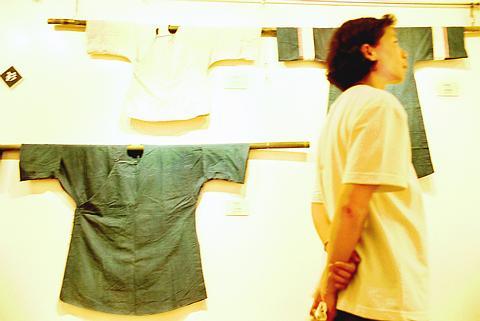
PHOTO: CHEN CHENG-CHANG, TAIPEI TIMES
Residents, however, have hardly any understanding of these Chinese words.
In fact, "Jing-shuei" is the term for the three-meter-long stone tanks still found abandoned alongside streams in the mountainous area of Yangmingshan. These tanks, most of which were severely damaged by farmers who later sought space to grow bamboo and oranges, were indispensable for their grandparents who lived by traditional indigo dyeing until a century ago.
Those engaged in the trade in Yangmingshan built these gigantic tanks along the water specifically to facilitate the preservation of fresh indigo plants leaves.
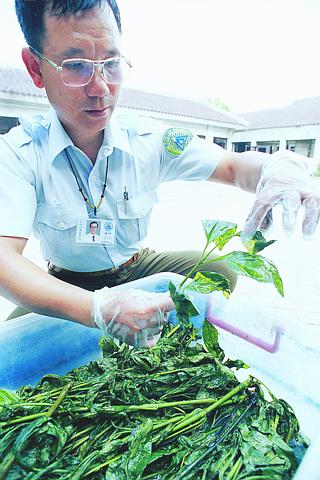
PHOTO: CHEN CHENG-CHANG, TAIPEI TIMES
Dyeing mills
Taiwan's traditional indigo dyeing was primarily applied to the making of clothes. The natural dyes were mostly derived from plants grown in humid mountains, such as Strobilanthes cusia Kuntze (
In Sanshia Village, Taipei County, famous for its preservation of local historic sights, signboards form the last remaining trace of the original collection of dyeing mills.
Before the decay of the industry, two thirds of the 60 stores on one street in Sanshia were engaged in natural indigo dyeing.
Liao Fu-ben (
"I remember the rumble of boiled water in the big pots where the workers cooked white clothes prior to the dyeing to avoid the fading of blueness afterwards," Liao said.
As dyeing equipment slightly varied from area to area, Liao said the room was occupied with ten indigo baskets, functioning like tanks, on the two sides of the aisle. Liao said the length of each basket was about 1.5m, while the depth was approximately two meters. "The workers had to stand on stools to reach the dye inside," Liao said.
Popular color
Lee Jui-tsang, (李瑞宗), an associate professor from Tsu-Chi College of Medicine and Humanities, who has been researching the subject for four years, noted that indigo was a hugely popular color in South-eastern China and Taiwan -- where its popularity enabled the dyeing industry to thrive -- partly because stains would show less on clothes of dark blue, while most of the population was engaged in trades involving arduous physical work.
In the meantime, at the threshold of the last century, the traditional industry began to shrink. Just as farmers today seek perpetually to maximize their profits by engaging in the most lucrative forms of farming, those who had originally operated indigo-dye plants, as in Yangmingshan, suddenly switched to the cultivation of tea instead. As a result, the industry faced crisis.
Otherwise, the evolution of Taiwan's natural indigo-dyeing industry, in fact, corresponded to the general history of the island. No sooner did the decrease of the indigo dying on the island begin than Germany's development of chemical dyes infiltrated the local market. As the application of chemical dyes reduced labor costs, the use of indigo hardly stood a chance.
Japanese colonial rule of Taiwan was also influential. The Taiwanese picked up the European and Japanese styles and stopped wearing indigo-dyed outfits. Only Hakka people, known for their respect for the "virtue of thrift," preserved the traditional pattern. Likewise, the planting of indigoes was only conserved in less accessible Hakka towns in the mountains by a handful of Hakka farmers, because poor transportation prevented them from acquiring imported dyes.
World War
As soon as World War I erupted, however, most men were conscripted by the Japanese armed forces while women were restricted to service in agriculture that met Japanese war needs only.
The industry of natural indigo-dyeing was killed off.
Lee said that the industry somewhat revived for a brief period, while the export of synthetic dyes from Germany was blocked during the war. After the war, however, with the revitalization of trade, the industry completely evaporated from the island.
According to field research by Lee and his wife Chen Ling-siang (
"Mill buildings that haven't changed much in terms of their exterior barely preserved traces of the previous intensive labor work," Lee said.
Faded glory
Similarly, those once glorious mills, filled with the unique smell of indigo dyes, have become nothing more than housing units or grocery stores for tourists.
"It is so sad that we couldn't even find anybody who was involved in the process to produce indigo-dyed clothes," Lee said.
He said that because the industry had fallen apart over many decades, all the old indigo hands had passed away.
Even Chen, who assisted her husband with the research and started a workshop in natural indigo-dyeing, says that identifying the meaning to her of indigo-dyeing was something of a personal struggle.
"I harbored a lot of doubt about the meaning of `locality' while the education and environment in which I was brought up stressed Western culture," Chen said.
"To search into our history is to seek genuine self-identification," said Tsai Bai-lu (
For this reason, the National Park has devised a program consisting of an exhibition, demonstrations and a workshop to introduce natural indigo-dyeing to the public from July through August. President Chen Shui-bian (
Lee, who agreed with Tsai's view about the relationship between local history and self-identification, further stated that Japan could serve as an excellent model for Taiwan in terms of making up what it has lost of this part of its history.
Japan's own natural indigo-dyeing industry had also encountered crisis but is now sustained by tourism, he said. The fineness of hand-made art and crafts as well as the extraordinary delicacy in color of natural dyes make the products especially popular among visitors.

CALL FOR SUPPORT: President William Lai called on lawmakers across party lines to ensure the livelihood of Taiwanese and that national security is protected President William Lai (賴清德) yesterday called for bipartisan support for Taiwan’s investment in self-defense capabilities at the christening and launch of two coast guard vessels at CSBC Corp, Taiwan’s (台灣國際造船) shipyard in Kaohsiung. The Taipei (台北) is the fourth and final ship of the Chiayi-class offshore patrol vessels, and the Siraya (西拉雅) is the Coast Guard Administration’s (CGA) first-ever ocean patrol vessel, the government said. The Taipei is the fourth and final ship of the Chiayi-class offshore patrol vessels with a displacement of about 4,000 tonnes, Lai said. This ship class was ordered as a result of former president Tsai Ing-wen’s (蔡英文) 2018
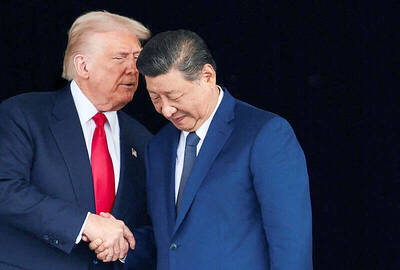
‘SECRETS’: While saying China would not attack during his presidency, Donald Trump declined to say how Washington would respond if Beijing were to take military action US President Donald Trump said that China would not take military action against Taiwan while he is president, as the Chinese leaders “know the consequences.” Trump made the statement during an interview on CBS’ 60 Minutes program that aired on Sunday, a few days after his meeting with Chinese President Xi Jinping (習近平) in South Korea. “He [Xi] has openly said, and his people have openly said at meetings, ‘we would never do anything while President Trump is president,’ because they know the consequences,” Trump said in the interview. However, he repeatedly declined to say exactly how Washington would respond in
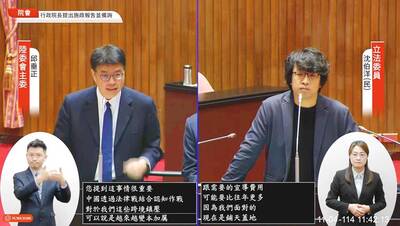
WARFARE: All sectors of society should recognize, unite, and collectively resist and condemn Beijing’s cross-border suppression, MAC Minister Chiu Chui-cheng said The number of Taiwanese detained because of legal affairs by Chinese authorities has tripled this year, as Beijing intensified its intimidation and division of Taiwanese by combining lawfare and cognitive warfare, the Mainland Affairs Council (MAC) said yesterday. MAC Minister Chiu Chui-cheng (邱垂正) made the statement in response to questions by Democratic Progressive Party (DPP) Legislator Puma Shen (沈柏洋) about the government’s response to counter Chinese public opinion warfare, lawfare and psychological warfare. Shen said he is also being investigated by China for promoting “Taiwanese independence.” He was referring to a report published on Tuesday last week by China’s state-run Xinhua news agency,
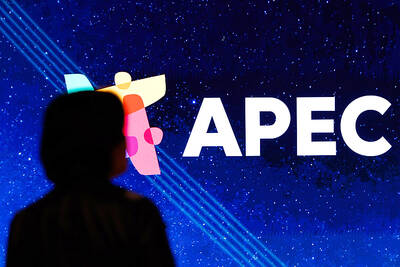
‘ADDITIONAL CONDITION’: Taiwan will work with like-minded countries to protect its right to participate in next year’s meeting, the foreign ministry said The US will “continue to press China for security arrangements and protocols that safeguard all participants when attending APEC meetings in China,” a US Department of State spokesperson said yesterday, after Beijing suggested that members must adhere to its “one China principle” to participate. “The United States insists on the full and equal participation of all APEC member economies — including Taiwan — consistent with APEC’s guidelines, rules and established practice, as affirmed by China in its offer to host in 2026,” the unnamed spokesperson said in response to media queries about China putting a “one China” principle condition on Taiwan’s